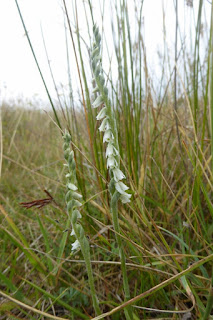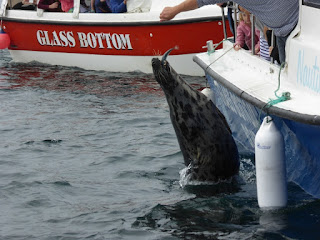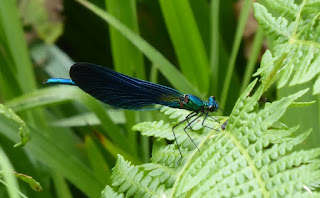Saturday August 20th and with a wet and windy day forecasted (unseasonably so) I headed off to Rame Head for a seawatch, something I haven't done before. It was cloudy and windy as I left Plymouth and true to form as I stepped off the bus at Whitsand Bay it absolutely chucked it down - typical. It quickly passed and I soon settled down between the rocks on the cliffs below the ruined chapel to scan the sea, sheltering from the occasional squally shower that rattled in on the breeze.
Rame Head
Amorique Ferry and The Great and Little Mewstones at Wembury
Amorique Close-up
A few gannets were passing by heading west, a variety of plumages from adult to juvenile with everything in between, and over the 3 and a half hours I was there watching there was a constant movement of them. Some of the immatures were quite oddly patterned which had my pulse racing at times. Manx shearwaters were also moving through west, probably an average of 5 a minute with the odd trickle and pulse at times, but in the final hours watch from 12:30 to 13:30 I only recorded 5 individuals. The only other birds of note were the occasional fulmar, oystercatcher and shag and great black backed, lesser black backed and herring gulls.
There was a report on Birdguides of 116 Balearic shearwaters passing by Rame Head from 06:30 to 14:30, I never saw any other birder there while I was present and other than a brief and distant view of a probable Balearic shearwater and a probable sooty shearwater I never saw anything unusual (some of the Manxies I saw close to shore did show some dark markings in their armpits but otherwise had very white underparts).
The highlight was a pod of common dolphins moving west off the headland, distant views and very unobtrusive as they moved by very quickly and out of sight. Their location was given away by a swirling group of gannets overhead but other than the occasional fin at the surface and occasional leap out of the waves I would have missed them. I counted 6 at the surface together but there were more present and it was quite exciting (and difficult) to track them across the Bay.
Sunday 21st August and I decided to head off to Dawlish Warren in the morning before the forecasted rain arrived in the afternoon. I caught the train to Dawlish and walked to the hide at Dawlish Warren to catch the high tide roost, noting an adult winter plumage Mediterranean gull amongst the gulls roosting along the beach along the way.
The island in front of the hide had roosting oystercatchers, carrion crows, Sandwich terns, herring gulls and great black backed gulls but not much else. Small waders started to fly into The Bight as the tide receded and scanning through them I managed to find myself a nice juvenile curlew sandpiper amongst the ringed plover, dunlin, sanderling and turnstone. It stayed asleep for most of the time with its head tucked under its wings but it stood noticeable taller than the nearby dunlin and had a lovely peachy pink flush across its breast. Eventually it woke up and flew nearer to me and started to feed amongst the salt marsh before flying off and out of sight but I had some very nice views in my scope.
Oystercatchers in front of the hide
Curlew Sandpiper (top right) with Ringed Plovers
Curlew Sandpiper (top right) with Dunlin and Ringed Plovers
Juvenile Ringed Plover
Adult Ringed Plover
Best of all was a surprise juvenile yellow legged gull right in front of the hide. I had been casually watching the juvenile herring gulls floating about and squabbling over scraps of wood and seaweed fished out of the water when I noticed a much paler and brighter looking bird amongst them. My first thought was that it was a juvenile great black backed gull but it was only slightly but noticeably larger than the herring gulls with a much heavier looking bill. Pale head, neck and breast, a slight dark smudge behind the eye, dark upperparts contrasting with the pale head and neck all noted before it flew up into the air showing a white rump and a black tail band and disappeared from sight! I was just about to call it out in the hide before it flew off and I really would have liked to have watched it properly for longer but as it flew off I felt a touch of shock at actually have found a yellow legged gull after all this time!
Heading back to the train station and I managed to find a gatekeeper, meadow browns, a green veined white, a large white, 2 male and a female common blue and a small copper along with a Pyrausta aurata, 6-spot burnets and 2 male yellow belles in the Greenland Lake area. Autumn ladies tresses were flowering and it was nice to see a pair of cirl buntings with 2 fledglings.
Male Yellow Belle
Male Yellow Belle - close up of antenna
Six Spot Burnets
Common Blue
Common Blue
Autumn Ladies Tresses
Autumn Ladies Tresses
Meadow Brown
Pyrausta aurata
Heading home on the train and the rain began to fall but it had been quite an interesting few days out with my first surprise UK life tick for 2016.

























































